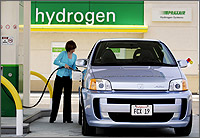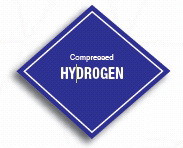Definition:
A Hydrogen vehicle is a vehicle that uses hydrogen as its on board fuel for motive power. Hydrogen vehicles include hydrogen fueled space rockets, as well as automobiles and other transportation vehicles. The power plants of such vehicles convert the chemical energy of hydrogen to mechanical energy either by burning hydrogen in an internal combustion engine, or by reacting hydrogen with oxygen in a fuel cell to run electric motors. Widespread use of hydrogen for fueling transportation is a key element of a proposed hydrogen economy.
Vehicles:
(The Toyota FCV concept, unveiled at the 2013 Tokyo Motor Show, is a practical concept of the fuel cell vehicle Toyota plans to launch around 2015.)
Buses, trains, PHB bicycles, canal boats, cargo bikes, golf carts, motorcycles, wheelchairs, ships, airplanes, submarines, and rockets can already run on hydrogen, in various forms. NASA used hydrogen to launch Space Shuttles into space. A working toy model car runs on solar power, using a regenerative fuel cell to store energy in the form of hydrogen and oxygen gas. It can then convert the fuel back into water to release the solar energy.
The current land speed record for a hydrogen-powered vehicle is 286.476 mph (461.038 km/h) set by Ohio State University’s Buckeye Bullet 2, which achieved a “flying-mile” speed of 280.007 mph (450.628 km/h) at the Bonneville Salt Flats in August 2008. For production-style vehicles, the current record for a hydrogen-powered vehicle is 333.38 km/h (207.2 mph) set by a prototype Ford Fusion Hydrogen 999 Fuel Cell Race Car at Bonneville Salt Flats in Wendover, Utah in August 2007. It was accompanied by a large compressed oxygen tank to increase power.
(The Chevrolet Sequel is a purpose-built hydrogen fuel cell-powered concept SUV vehicle developed by General Motors)
Buses:

Fuel cell buses (as opposed to hydrogen fueled buses) are being trialed by several manufacturers in different locations. The Fuel Cell Bus Club is a global fuel cell bus testing collaboration.
Hydrogen was first stored in roof mounted tanks, although models are now incorporating on board tanks. Some double deck models use between floor tanks.
Bicycles:

Pearl Hydrogen Power Sources of Shanghai, China, unveiled a hydrogen bicycle at the 9th China International Exhibition on Gas Technology, Equipment and Applications in 2007.
Infra Structure:
The hydrogen infrastructure consists mainly of industrial hydrogen pipeline transport and hydrogen-equipped filling stations like those found on a hydrogen highway. Hydrogen stations which are not situated near a hydrogen pipeline can obtain supply via hydrogen tanks, compressed hydrogen tube trailers, liquid hydrogen tank trucks or dedicated onsite production.

Hydrogen use would require the alteration of industry and transport on a scale never seen before in history. For example, according to GM, 70% of the U.S. population lives near a hydrogen-generating facility but has little access to hydrogen, despite its wide availability for commercial use. The distribution of hydrogen fuel for vehicles throughout the U.S. would require new hydrogen stations that would cost, by some estimates approximately 20 billion dollars and 4.6 billion in the EU. Other estimates place the cost as high as half trillion dollars in the United States alone.

The California Hydrogen Highway is an initiative to build a series of hydrogen refueling stations along California state highways. As of June 2012, 23 stations were in operation, mostly in and around Los Angeles, with a few in the Bay area. South Carolina also has a hydrogen freeway project, and the first two hydrogen fueling stations opened in 2009 in Aiken and Columbia, South Carolina. The University of South Carolina, a founding member of the South Carolina Hydrogen & Fuel Cell Alliance, received 12.5 million dollars from the Department of Energy for its Future Fuels Program.
Criticism:
K. G. Duleep commented that “a strong case exists for continuing fuel-efficiency improvements from conventional technology at relatively low cost.” Critiques of hydrogen vehicles are presented in the 2006 documentary, Who Killed the Electric Car?. According to former U.S. Department of Energy official Joseph Romm, “A hydrogen car is one of the least efficient, most expensive ways to reduce greenhouse gases.” Asked when hydrogen cars will be broadly available, Romm replied: “Not in our lifetime, and very possibly never.” The Los Angeles Times wrote, in February 2009, “Hydrogen fuel-cell technology won’t work in cars. … Any way you look at it, hydrogen is a lousy way to move cars.”
The Wall Street Journal reported in 2008 that “Top executives from General Motors Corp. and Toyota Motor Corp.
Tuesday expressed doubts about the viability of hydrogen fuel cells for mass-market production in the near term and suggested their companies are now betting that electric cars will prove to be a better way to reduce fuel consumption and cut tailpipe emissions on a large scale.” The Economist magazine, in September 2008, quoted Robert Zubrin, the author of Energy Victory, as saying: “Hydrogen is ‘just about the worst possible vehicle fuel'”. The magazine noted the withdrawal of California from earlier goals: “In March [2008] the California Air Resources Board, an agency of California’s state government and a bellwether for state governments across America, changed its requirement for the number of zero-emission vehicles (ZEVs) to be built and sold in California between 2012 and 2014. The revised mandate allows manufacturers to comply with the rules by building more battery-electric cars instead of fuel-cell vehicles.”


